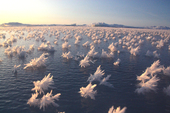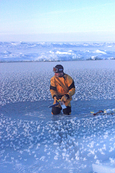Highlight
Frost Flowers, Microbes and the Origin of Life
Achievement/Results
In a study combining oceanography, microbiology, and planetary sciences, NSF-funded researchers at the University of Washington have discovered fascinating new aspects of so-called “frost flowers” that grow on Arctic ice fields. These delicate ice structures turn out to host microbes that survive to extremely cold temperatures, informing us about the limits of life when we search on other ice-covered planets and moons for possible extraterrestrial life. They also produce chemicals such as formaldehyde that may give clues about the origin of life on the early Earth.
Research in the Arctic and back home in the Seattle lab over the past three years has been supported by an NSF Fellowship to Jeffrey Bowman from the Integrated Graduate Education and Research Training (IGERT) program, and his mentor Professor Jody Deming of the University of Washington Department of Oceanography. Around their research icebreaker in the central Arctic Ocean new ice grows on long open cracks that network amongst the thick floes of pack ice. Abruptly the surface of this new ice changes texture. The cold, moist air above the open cracks becomes saturated and frost begins to form wherever an imperfection can be found on the ice surface. From these nucleation points the flower-like frost structures grow vertically, quickly rising to centimeters in height. The hollow tendrils of these “frost flowers” begin to wick moisture from the ice surface, incorporating salt, marine bacteria, and other substances as they grow. The fog dissipates and the Arctic sun lights the surface of the frost flowers, initiating a cascade of chemical reactions. These reactions can produce formaldehyde, deplete ozone, and actually alter the chemical composition of the lower atmosphere.
Although frost flower blooms are frequently observed in both polar oceans, little is understood about the physical, chemical and biological nature of these structures. To investigate their microbiology Bowman and Deming learned to grow frost flowers in a freezer lab at the University of Washington before moving their study into the field, collecting frost flowers during several challenging expeditions. With these first samples they have begun to develop the concept of frost flowers as a microbial habitat. Their goal is to probe the secrets of microbial life in very cold environments, a priority of the astrobiology community. Since many of the planets and moons in our solar system that might harbor life are very cold and covered in ice, determining the habitability of these planets and moons requires an understanding of the limits of life (as we know it) in the very coldest environments on Earth.
Bowman and Deming have discovered that bacteria are consistently more abundant in frost flowers than in sea ice. Since microscopic pockets in sea ice are known to support an active community of psychrophiles (cold-loving microorganisms), even in the coldest months of the year, these results are encouraging. Frost flowers, however, are much colder than sea ice. In their last field season at Barrow, Alaska, working between intense blizzards blowing off the Beaufort Sea, they collected frost flowers and underlying sea ice for a comparative analysis of the life they host. Techniques designed to identify weakly respiring organisms are being employed in one of the coldest natural environments studied so far.
Finally, while frost flowers are too harsh an environment for most life, they may have ironically played a role in the origin of life on Earth. Formaldehyde, found in high concentrations in some frost flowers, is useful for making simple sugars including ribose. Ribose is an essential component of RNA, a molecule used to temporarily encode genetic information by every cell on Earth. Although today DNA is the primary molecule for passing on genetic information from one generation to the next, RNA may have been the first molecule to do so. On the early Earth frost flowers could have contributed ribose to a global “primordial soup” of molecules that allowed the first genetic system to form. Investigating this hypothesis is a particular challenge, as simple sugars are quickly consumed by ubiquitous and omnipresent microbes in today’s natural environment. To continue this line of research, Bowman and Deming are building a special chamber to grow frost flowers under ultra-clean conditions.
Address Goals
Primary Strategic Goal = Discovery. This activity is all about new discoveries in the natural environment as we further our goals of understanding the extreme forms of microbial life in the Arctic, and how this may be applied to the origin of life here on Earth, as well as looking for life on other moons and planets.
Secondary Strategic Goal = Learning. This activity is being conducted by one of our IGERT Trainees and will be the main part of his PhD thesis, and thus it contributes to the nation’s science workforce.







